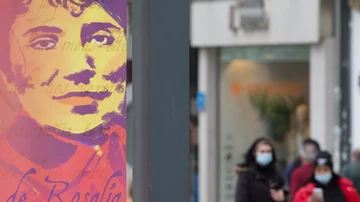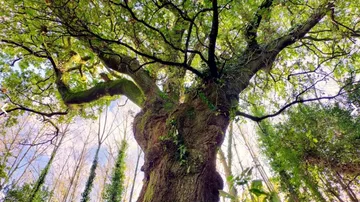Goodbye, rivers; goodbye, sources; goodbye, little streams; Goodbye, see two of my eyes, I don’t know when we’ll see each other. Almost any Galician in the diaspora has said, written or thought in these words some of the many times that he has had to leave Galicia back to your reality. So much is the love for the Galician homeland that this poem exudes that Rosalía de Castro is celebrated always, wherever you go. The day his more than well-known ‘ was publishedGalician songs‘, in 1863, is the same one that is celebrated almost every year as the community’s patron day, the Galician Letters Day, every May 17.
Today, February 23, is not that but also It is a day to celebrate in Galicia thanks to one of the most recognized figures in literature and a key person also in the feminist movement. In 2022 she gave a lot of talk about a feminist mural that was vandalized several times in the Madrid neighborhood of Ciudad Lineal, to be later ‘recovered’ thanks to the community of neighbors. In it great feminist mural of Ciudad Lineal, 15 women; among them, the one that together with Gustavo Adolfo Bécquer is considered forerunner of modern poetrywhich he wrote in both Spanish and Galician.
Why is February 23rd Rosalía de Castro Day?
But this Rosalia de Castro day It doesn’t have as much time as one might think: this is the second year that it has been celebrated on February 24. Of course, it is not new either: until then it was celebrated on February 23, the date on which it is believed that the poet was born in Santiago de Compostela. The truth is that until 2021, February 24 was the ‘official’ day because it was the date that appeared on the baptismal of the writer, but thanks to the investigation of the Galician Sagrario Abelleira, new information about the biography of Rosalía de Castro became known.
Specifically, on February 23, 1837 at 4:00 in the morning was the time the poet was born, according to what appears written in the marriage file of Rosalía de Castro and Manuel Murguía, recovered from the Diocesan Historical Archive of Madrid thanks to Abelleira. Once this information came to light, the Xunta changed the date on which Rosalía de Castro’s day would be celebrated so that it was in accordance with the actual date of her birth.

The Week of Galician Literature 2020 in Lugo | Carlos Castro/Europa Press
Five curious things about Rosalía de Castro
Rosalía de Castro in a thousand languages
In 2013, the Galician writers Malores Villanueva and Xosé Henrique Costas coordinated the voluntary translation of two of Rosalía de Castro’s most famous poems: ‘Adiós, ríos; goodbye fontes’ and ‘Aires, airiños, aires’, both included in her ‘Cantares Gallegos’. The initiative, to celebrate the 150th anniversary of the publication of his work better known, it later became managed by the Rosalía Foundation itself, hand in hand with the University of Vigo. Today it is possible to read ‘Goodbye, rivers; goodbye, fontes’ in 30 languagesgoing through Bengali or Esperanto, as well as Irish Gaelic or Sardinian, while ‘Aires, airiños, aires’ has been translated into 22.
The first (Galician) feminist
Although many times it is not included in the lists of the first Spanish feminists Together with other better known women such as Concepción Arenal or Emilia Pardo Bazán, or with much more repeated ones such as Clara Campoamor or Victoria Kent, Rosalía de Castro wrote what could be considered the first feminist manifesto published in Galicia, ‘Lieders’, which saw the light of day in ‘El Álbum del Miño’ (1858); a deep hymn to the equality of women, to freedom and independence. “The hope of glory has never dominated my soul, nor have I ever dreamed of laurels that oppressed my forehead. Only songs of independence and freedom have stammered from my lips, although around me I had felt, from the cradle already, the noise of chains that they should imprison me forever, because the patrimony of women are the shackles of slavery. I, however, am free, free like the birds, like the breezes; like the Arabs in the desert and the pirate in the sea”.
The writer with the most streets with her name
Rosalía de Castro is the literata (woman) with the most streets in Spain: according to a report published in 2010 by the company 11811, in that year there were a total of 289 streets throughout the country named after the poetthe sixth without taking gender into account, behind Jacinto Benavente (305), Rafael Alberti (429), Antonio Machado (741), Federico García Lorca (903) and Miguel de Cervantes (1,609).
Environmentalism and Rosalía de Castro
Rosalía de Castro was a staunch defender of nature: A little less than a year ago, the Royal Botanical Garden of Madrid hosted the exhibition ‘El herbario de Rosalía de Castro’, a compilation of many of the plants to which the Galician poet dedicated some of her words, and in ‘On the shores del Sar’ includes more than one harsh criticism of logging in the mountains of Galicia —”Under the relentless ax, how quickly oaks and oaks fell to the ground! (…) The birds no longer sing their love songs in them, nor do they come together when May dawns on the fronds that remained from their bare oaks”—.
He came to talk about oaks so much that he even defended one that is still standing today, known as the carballo (oak) of the Banquet of Conxo, near Santiago de Compostela. This imposing oak of more than 250 years was at the time accompanied by nearly a thousand other trees; to this day they do not reach fifty. In 1856 the carballo witnessed the Democratic Banquet of Conxo, a revolutionary act in which the European ideals of freedom, equality and fraternity were claimed, and for which Rosalía de Castro herself interceded. in 2022 It was considered the Tree of Spain, and the second Tree of Europe. Another sign of her early environmentalism was the —according to tradition— fig tree that Rosalía would have planted next to the Casa da Matanza de Padrón; The A Coruña City Council decided to plant a “daughter” of that fig tree in the Santa Margarita park in 2021.

The Carballo de Conxo, the Galician tree of freedom that could become the best in Europe | Tree of the Year
From daughter without parents to being able to be officially recognized in 2021
The author of ‘Follas novas’ was baptized at the time as “daughter of unknown parents”: born María Rosalía Rita, at the christening she was accompanied by her mother’s maid, María Francisca Martínez, and the girl arrived “without a number because she did not go through the inclusa” (the inclusa was a cradle or foundling where abandoned children were raised). Rosalía was the daughter of an impoverished noblewoman and a priest, although it is believed that in her early years she was raised by her paternal aunts.
Although later it is recorded that she lived with her mother, Teresa de Castro, the absence of official documentation did not allow us to affirm that the girl had been recognized at some point, after being born from a bad relationship. However, in the work that Sagrario Abelleira published after finding the documents that confirmed her date of birth, there are also others that show that Teresa de Castro, a single mother, recognized her daughter before a notary in 1843, at which time he also recognized that the girl had been breastfed for six months in the village of Santo, in Ortoño.
Three (short) poems by Rosalía de Castro
‘Quíxente so much, meniña’ (‘Galician Songs’, 1863)
“Quíxente so much, little girl,
have such a great love,
that for me you were lua,
white dawn and bright sun;
clean water in a fresh source,
rose of the garden of God,
alentiño with my peito,
life of my heart”.
So che falin one day
little boy from San Lois,
all oppressed with anguish,
all burning with passion,
while you were picking me
depinicando unha frol,
because eu non vise os teus ollos
that reflected treason
Dempois that if you told me,
in proof of your love
give me a caraveliño
what a garden not heart
Damn black caravel,
that fireu me of pain!
More to cross the river,
o caravel afondou!…
so bo camino ti mild
como o caravel levou.
‘From the blue sea the transparent waves’ (‘On the shores of sar’, 1884)
From the blue sea the transparent waves
while soft they murmur
on the sand, even my feet rolling,
temptresses kiss me and seek me.
Restless lick the edge of my plant,
gracefully throw me their snowy foam,
and I think that they call me, that they attract me
towards its humid rooms.
More when anxious I want
follow them across the liquid plain,
my foot sinks into the transparent lymph
and they make fun of me.
And they run away, abandoning me on the beach
to the ground, endless struggle,
as in the sad beaches of life
Fortune abandoned me fickle.
‘Ti onte mañan eu’ (‘Follas novas’, 1880)
Cain so low, so low
that to light wave min non vai.
Lost sight of the stars
and I live in the dark.
Mais, agarda… or that you riches,
insensitive or meu eagerness!
Inda I’m alive… Inda I can
go up to avenge me
Throw stones or fall,
tiraille even if it’s a cent,
pull… that when you fall
hanvos de face-the same.
Source: Lasexta
Bruce is a talented author and journalist with a passion for entertainment . He currently works as a writer at the 247 News Agency, where he has established himself as a respected voice in the industry.











